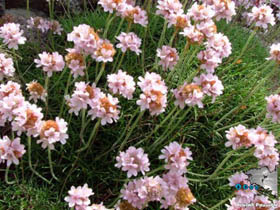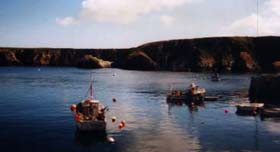| The island of
Ouessant,
the « watch dog » of the Channel by Delphine (Nov 19, 2005) |
|
|
The island of Ouessant is situated in the Atlantic Ocean, 20 km west of Brittany, in the Finistere. Ouessant is a low and small island whose highest point is 60 metres above the sea level. The island is 3.5 km wide, 8 km long and the area is 15.6 sq km. The population is 1,062 inhabitants.
The main town is Lampaul, situated on the west of the island. It’s a « watch dog » for the harbour of Brest, particularly at the time of conflict with the English. Ouessant is a sentry who watches the sea.
The rail of Ouessant is one of the busiest sea road of Europe. There are nearly two hundred thousand passages per year, and sailing incidents are frequent. Very often the mist is so thick that the lighthouses have difficulty in leading boats. The storms can last 10 days with enormous winds from the west. However, the climate is rather mild. The temperature gaps are weak and the rain is moderate. The coasts of Ouessant are so dangerous that several lighthouses sweep across the sea and the country at regular intervals.
The lighthouse of Créac’h, for example, is easily recognizable. It is on the western point of the island. Brought into service in 1863, electrified in 1888, it is one of the most powerful in the world. It keeps a watch on a traffic of more than 50,000 ships per year. Still now, to sail alongside Ouessant isn’t always easy!
The breeding of sheep is an important agricultural tradition on the island. The Ouessantin sheep is specific to the island. It is 50 cm high, it weighs a maximum of 18 kg and its wool is brown (but today dark sheep are rare). These sheep live almost all winter in total freedom. In the North of Ouessant, the day of the sheep fair is on the first Wednesday in February. In fact, in this fair there is no sale but the fair allows the inhabaitants of Ouessant to recover their flocks, thanks to the ears marked of the sheep. Then the sheep are kept next to the houses during the shearing, and they find their freedom again in autumn. Presently, there are 900 sheep in Ouessant. |
Since 1969, the island has been integrated into the regional natural reserve of Armorique. The island constitutes the best French site for the autumnal observation of the Siberian birds and many exotic species.
The island presents to the visitors a vast natural zone. The extension of the habitat remains restricted, the interventions of man are limited to the inhabited sectors. The marine flora is of a great diversity. It presents a variety of settlements of algae which one discovers at the time of the low tides. The vegetation adapts to the hard climatic conditions of the island and sets itself up on the rock. You can see quantities of North-American sparrows passing by, deviated from their migratory route by the storms.
Located close to the lighthouse of Créac'h since 1984, the Environment Study Center of Ouessant accommodates the amateur observers and the scientists all year round.
Ornithologists also search for sea-beds to observe some specimens of big sperm whales and groups of dolphins. The meeting with seals is due to a simple luck, reserved to the only islanders and fishermen. A characteristic of the island is the absence of any reptile, except the lizard and a variety of toad of an species unknown elsewhere.
I was in Ouessant last year and I loved this island because you are totally disconnected from the world. The landscapes are very beautiful. You can eat delicious fish and shellfish, you can go fishing in the morning or if you prefer, you can eat the traditional savoury pancake of Brittany accompanied with cider. To visit the island you can rent bikes or walk, but it’s nicer to ride across the island on a bike. And if you want to go to Ouessant, I advise you to bring a hat and a scarf !
To conclude, Ouessant is a beautiful island which has remained
natural and wild. |
|
If you wish to react to this article, write to the editor. |
|









